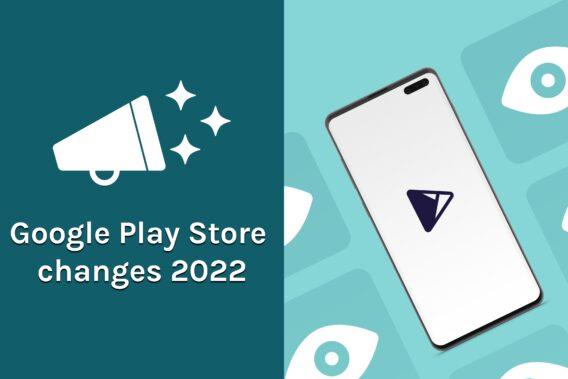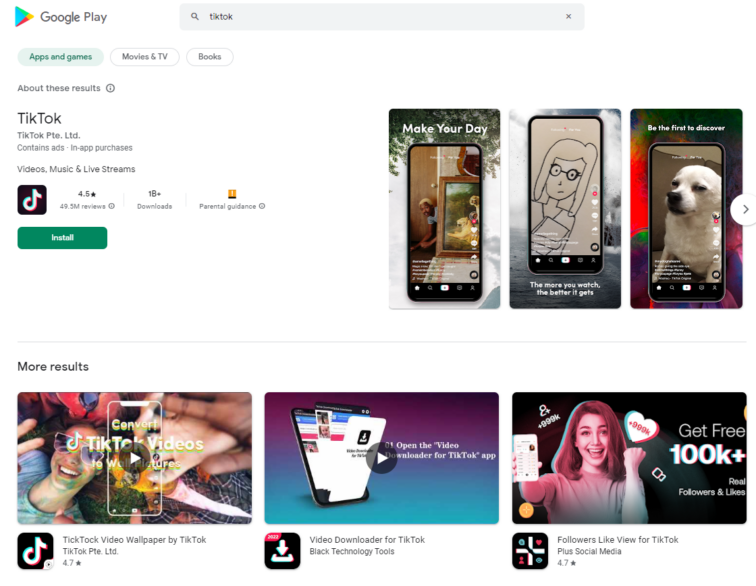Google Play Store changes, updates and app marketing impact
As Google is developing quickly, new changes are rolling out every year. 2022 was not an exception and rather the year of significant changes on the backend side and security policy. In this article, we will guide you through the major changes that Google introduced in 2022 and their impact on the app marketers' and developers' daily work.

Privacy and security initiatives in Google Play Store 2022
One of the main mottos of the Google 2022 initiatives is to ”keep Google Play safe for users and developers”. Therefore, Google’s team puts a lot of effort into improving the Play Store’s security ecosystem. Google initiated three essential improvements regarding the privacy and security of the Google Play Store:
- Helping developers make more informed choices about SDKs
- Protecting apps from privacy and fraudulent activity
- Helping users understand the app’s data safety practices
Let’s summarize the main changes of these initiatives.
Aligning SDKs with Google Play Store policies
The biggest challenge that app developers face is choosing the high-quality SDK that can be aligned with Play policies. For the last years, Google has been working on providing a tool that helps make SDKs better and safer to use on Google Play, intending to help SDK providers, app developers, and end-users. As a result, in 2020, they launched the Google Play SDK console. It provides usage statistics, crash reporting, and the ability for SDK providers to communicate to app developers through Play Console and Android Studio.
More than 80% of the top companies providing commercial SDKs across key use categories are already registered with and use SDK Console.
What does it mean for app marketers and developers? Based on the direct communication line between SDK providers and Google Play, Google can now guide you on SDK issues. In other words, the system will warn you before publishing a release with a problematic SDK version if there is an issue.
We expect that by improving communication among Google Play, SDK providers, and app developers, we can dramatically improve the quality and security of third-party code across the Play ecosystem. We’ve also recently launched Google Play SDK Index, a new public portal that lists widely used commercial SDKs and provides data and insights about each one.
Google Play SDK Index includes over 100 SDKs and is available now at play.google.com/sdks.
Protecting apps from privacy and fraudulent activity
Another security measure by Google comes from improving Play’s app integrity tools. Google Play App Signing helps millions of apps on Google Play to ensure that app updates can be trusted. However, since Play App Signing used state-of-the-art storage to protect and manage keys, the details haven’t been publicly disclosed. This year, Google has announced that Play App Signing will use Google Cloud Key Management to protect signing keys. Moreover, all developers will soon be able to perform an app signing key rotation. In other words, developers can trigger an annual key rotation from within the Play Console.
What does it mean for app marketers and developers? With a Google Cloud Key Management, you can review public documentation, including the storage specifications and security practices that Google uses to protect your keys. In other words, Google will soon be using Cloud Key Management for all newly generated keys, followed by securely migrating eligible existing keys.
To maximize security, Google Play Protect will also verify your app updates using rotated keys for older Android releases that don’t support rotation going all the way back to Android Nougat. We also offer an API that you can use to protect your app, your IP, and your users from abuse and attacks.
The new Play Integrity API is now available to all apps and games. According to Google, now app developers can use the API to detect fraudulent and risky interactions, such as traffic from modified or pirated app versions and rooted or compromised devices. The Play Integrity API is already being used by developers like Truecaller, Wooga, and GameInsight to protect their apps and games from abuse that can cause significant revenue loss and harm both the users and the developers’ brands.
New Data Safety sections
Looking from another angle, Google has also introduced privacy and security changes that will now be more transparent for app users. The new Data Safety section in the app store listing gives app developers a way to showcase their approach to privacy and security so that users can make informed decisions about their apps.
What does it mean for app marketers and developers? All developers must submit a data safety form and privacy policy for their apps in Play Console by July 20, 2022. Data safety and privacy are the information that users will be able to see in the store listing on the Play Store. App marketers and developers risk being punished with the next app update submission by not submitting privacy information until Google’s deadline.
Supportive app quality tools
App quality is a vital part of your app business. Moreover, it affects everything. To monitor the quality of apps in a more detailed way, Google has introduced tools that will help to improve the overall quality of apps:
- Developing Reporting API – you can access Vitals’s metrics and issues data outside Play Console, including crash and ANR rates, counts, clusters, and stack traces, and integrate them into your own tools.
- Crashlytics app – developers and marketers can now link the Play app with the Crashlytics app to see Play track information in Crashlytics.
- Reach & Devices – this tool enables you to build a business case for quality, wherever you are in your lifecycle, by providing insights on your user and issue distribution. It now includes revenue and revenue growth metrics for apps that monetize on Play.
- Android Automotive and, soon, Wear OS – Google made it easier for developers to test an app on different form factors, allowing them to independently perform internal and open testing on each of your form factors.
- In-app updates API – this API lets your app check if there’s an update available, prompt the user, and then complete the update, all without the user leaving the app. The API will now let your app know if there’s an update within 15 minutes instead of 24 hours. The updated UI will also display your “what’s new” text within the app so users can know what features they’re getting.
What does it mean for app marketers and developers? All the improvements in existing Google tools and introduced new ones aimed to improve the quality check of apps. On the one hand, app marketers and developers now have a wider variety of different tools that helps them to check the app performance. On the other hand, it overcomplicates the app optimization process as marketers will need to jump from one tab to another. These changes lead to tool adoption for app marketers and developers who use external optimization tools like App Radar. In other words, whenever app stores change something or improve their usability, third-party tools need to change their crawling settings to collect accurate data. Therefore, you could notice some issues around the crawling processes of Google Play Store in app optimization tools.
Google Play Store helps businesses to succeed
In 2022, Google has also aimed to help app developers and marketers to grow their business by helping acquire new users, engage existing ones, and drive revenue growth. Here are 5 top Google Play improvements that relate to the app growth:
- Drive more conversion with custom store listing – from now on, you can create custom listings with unique deep links. It means you can show different listings to users, depending on where they come from, such as showing various screenshots based on the channel from which they arrived. Moreover, Play Console also provides analytics for each of your custom listings, so you can see just how effective each variation is and optimize them over time. Also, keep in mind that now app marketers can create up to 50 custom store listings.
- Improved store listing experiments – the updated store listing experiments provide results more quickly for most experiments and more transparently. It recommends your experimental setup, gives you control over confidence intervals, and uses new algorithms that enable continuous monitoring. In other words, it means that now you can run more experiments with more confidence.
- Deep links – Google aims to launch a new Play Console page dedicated to deep links. This page will collect all the information and tools related to your app’s deep links in one place. In other words, marketers and developers will have a quick and comprehensive snapshot of their current setups to identify and troubleshoot issues.
- LiveOps cards and events – a feature that allows you to submit content to be considered for featuring on the Play Store. Earlier this year, Google launched a new LiveOps type called Offers. It lets developers entice users with everything from discounts to value-added deals, like free items or shipping. Now Google team is introducing a deep linking for LiveOps, which allows developers to drop users directly into the most relevant part of their app or game. This feature will help delight users and increase conversions.
- Play Commerce – helps convert engaged users to buyers with tools and features that go beyond just payment processing. Moreover, Google keeps adding new features to help app marketers and developers to build a flexible monetization strategy that suits a specific app type.
What does it mean for app marketers and developers? Long story short – check out the described improvements and new tools! We are confident that Google listens to its audience carefully and improves accordingly. Therefore, the only way to decide how it will influence your daily job is to try it out and find the most beneficial features for your app business.
Google Play Store redesign 2022
Another essential news from Google is the redesigning of the Google Play desktop. You can now see the new layout and design of the desktop version of the Play Store. The main layout changes apply to replacing the left-hand sidebar with the updated and modern top navigation. The top navigation now highlights tabs for games, apps, books, movies, and kids. At the same time, the top-right corner of the window displays your profile photo, an overflow menu for help resources, and a search button.

What does it mean for app marketers and developers? The primary purpose of redesigning the desktop version of Google Play was to align the designs between mobile and desktop. Since Google hasn’t changed the desktop Play Store for a long time, marketers and developers met a new design quite well. Moreover, a new design allows you to use the negative space to stand out with your app listing.

What to keep in mind with new Google Play Store changes in 2022
Google is coming up with many updates and improvements every year, and 2022 is not an exception. The main focus of Google this year is to fix existing bugs, improve security and privacy within the store, and provide more opportunities to grow the apps. As a user acquisition tool, we know that even the tiny changes might entirely change how app marketers and developers used to work with Google Play Store. Therefore, don’t forget to:
- update your app’s privacy terms,
- check out new SDKs and fraud protection guidelines,
- try out updated UA features like custom store listing, store listing experiments, deep links, and play commerce.
And be patient with all external tools you use to optimize your app on Google Play, as they need time to adjust to new google changes. Keep in touch with new updates!

Latest Posts

iOS App Product Page Localization: How to Use it the Right Way to Improve ASO
Top 10 Most Downloaded Games in Google Play Store (July 2025 Update)
Google Play Store Listing Experiments: How to Run Native A/B testing for Android Apps for Free!
12 Best Mobile Measurement Partners (MMPs) to Consider for Your Mobile App Attribution in 2025
Related Posts

